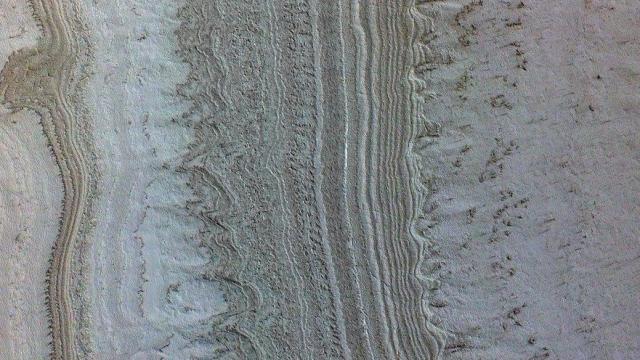Scientists have been arguing for years about ambiguous radar scans of Mars’ south pole. Do they reveal underground lakes of liquid water? Or something else? Two new papers out this week have added even more intrigue to the controversy.
In 2018, a team of Italian scientists claimed to have discovered a subglacial lake near the Martian south pole using radar data from the Mars Express satellite. The discovery was met with scepticism, with other scientists suggesting alternatives like lumps of clay that could have produced the same reflection patterns. It’s a heady debate, because of water’s implications for life. While most scientists agree that Mars used to be very wet, the H2O it has left seems to be all ice.
The debate is reignited this week with new evidence from NASA’s Mars Global Surveyor satellite that supports the liquid water hypothesis. The radar signals from the 2018 study pointed to a 19 km-wide (20-kilometre) region around a mile beneath the surface, which the researchers interpreted as a subglacial lake or a patch of liquid water. In order to confirm that interpretation, a different team examined satellite data of the surface topography of the same region. Their analysis, published this week in Nature Astronomy, revealed a 6- to 15-mile (10-15 kilometre) undulation that’s made up of a depression and a corresponding raised area, which is similar to undulations found over subglacial lakes here on Earth.
The team then ran a computer simulation of ice flow that’s consistent with the conditions on Mars, and the simulations generated undulations of similar size and shape to those observed on Mars’ ice cap surface. The study suggests that there is indeed an accumulation of liquid water beneath the planet’s south polar ice cap. “The combination of the new topographic evidence, our computer model results, and the radar data make it much more likely that at least one area of subglacial liquid water exists on Mars today,” Neil Arnold, a researcher at Cambridge’s Scott Polar Research Institute and lead author of the study, said in a statement.
But a separate new paper suggests that the liquid water radar data was in fact a result of interaction between different geological layers on Mars, producing a reflection pattern that could have been misinterpreted as liquid water. That study, also published this week in Nature Astronomy, provides an alternative explanation to the 2018 finding. The team behind this study created a simulation of layers made up of four materials — atmosphere, water ice, carbon dioxide ice, and basalt — and measured the layers’ interaction with electromagnetic radiation as it passes through them.
They found that, depending on the thickness of the layers and how far apart they are, they produced similar reflections to the ones observed in the radar data of 2018. “On Earth, reflections that bright are often an indication of liquid water, even buried lakes like Lake Vostok [under the surface of the East Antarctic Ice Sheet],” Dan Lalich, research associate with Cornell Centre for Astrophysics and Planetary Science and lead author of the study, said in a statement. “But on Mars, the prevailing opinion was that it should be too cold for similar lakes to form.”
“None of the work we’ve done disproves the possible existence of liquid water down there,” Lalich added. “We just think the interference hypothesis is more consistent with other observations. I’m not sure anything short of a drill could prove either side of this debate definitively right or wrong.”
Temperatures on Mars can dip to around -220 degrees Fahrenheit (-140 degrees Celsius). Those frigid conditions comprise the main argument against any liquid water flowing on the Red Planet. But the researchers behind the latest pro-water study argue that geothermal heat from within the planet could be enough to keep the water in liquid form.
Water is a main ingredient for life on Earth, but that doesn’t necessarily mean our sacred life juice would sprout lifeforms elsewhere in the universe. The debate over water does have implications for future crewed missions to Mars, though, especially if we ever want to set up a sustained presence there.
